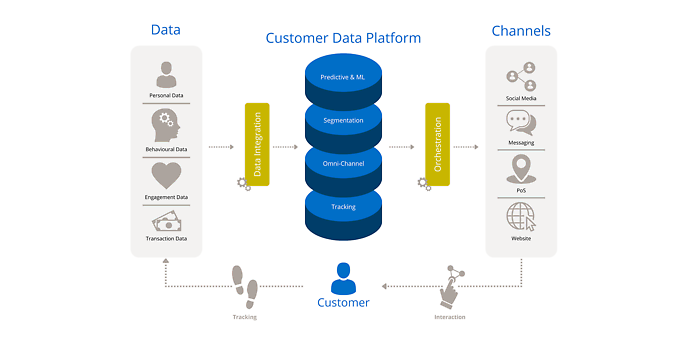21. June 2022 By René El Fatuaki
Unified commerce – the future of commerce
One of the main consequences of e-commerce is that customers now demand more from retailers. In the face of growing competition, traditional marketing and sales strategies are no longer up to the task of providing an enduring customer experience. The shopping experience must be consistent across all sales channels, giving rise to the omnichannel concept, which has served as a benchmark for a cross-channel customer experience in e-commerce for many years. The problem with it is that the underlying systems are often not interlinked or that interactions between them are limited. As a result, the shopping experience is not consistent across all channels. But thanks to unified commerce, which successfully builds on the omnichannel approach, inconsistencies across channels are a thing of the past.

At its core, unified commerce is a single, central platform. By integrating communication channels on a single platform, the unified commerce strategy provides for a uniform customer experience across all touchpoints. Unlike other approaches, the unified commerce strategy is focused squarely on the customer. It provides customers with a personalised experience in real time, even when they move from one channel to another.
Unified commerce combines e-commerce, order management, customer relationship management, point of sale and much more on one platform. Due to the broad scope of the topic, I will primarily focus in the sections below on the central role played by the customer data platform and explain how order management can be optimised through unified commerce.
Why is a customer data platform essential for unified commerce?
In the past, companies maintained a multi-channel presence and collected a large amount of data on each one of them. The resulting data silos contained a lot of redundant data. Not only that, they also prevented the companies from making full and targeted use of the data since the silos were usually considered separately from each other. Because of this, managers were making decisions based on incomplete and inconsistent data, making it difficult to take meaningful action to improve the customer experience.

The underlying structures of a customer data platform
If you are to successfully provide this type of end-to-end customer experience in line with the unified commerce strategy, you need to merge all of your data into one platform. A customer data platform (CDP) is used to collect data. According to the CDP Institute’s definition, a customer data platform is ‘packaged software that creates a persistent, unified customer database that is accessible to other systems’. By merging data from many different sources, you can create a 360-degree view of your customers. Machine learning is an excellent way to handle large volumes of data in order, for example, to spot market trends, deliver personalised product recommendations or optimise pricing.
How does a customer data platform work?
The core task of a CDP is to aggregate all customer data at one central location. This involves interlinking various CRM instances as well as databases that do not typically exchange customer data, such as marketing tools, customer service software or e-commerce engines. In order for data to be collected, a customer ID that is uniform across all devices is needed. This is also true for anonymous customer profiles, which can be linked when establishing the identity of the customer at a later time. A unified profile is created when consolidating the data, a process also referred to as identity resolution. In the final step, the unified profile is provided to the user in real time in the form of visual insights.
The advantages of a customer data platform
- Customers integrated in real time across all touchpoints
- Uniform view of customer data across all departments
- Consistent customer experiences created across all channels and devices
- Unified sources of customer data
For more information on CDP, I recommend my colleague Thomas Reimer’s blog post Customer data platform (CDP).
Distributed order management: a cross-channel approach that points the way forward
If order management is split among several applications, inventory data cannot be updated in real time. This could be irritating for the company and for the customer who, for example, cannot find a product on a retailer’s product overview page, even though it is available at its shop downtown. In theory, the product could be shipped directly from the shop to the prospective customer. However, this information is not available to users visiting the online shop who will not purchase the product online from this retailer for this reason.
As this example illustrates, order management is one of the biggest challenges for companies with multiple distribution channels. But by using distributed order management (DOM) as part of their unified commerce strategy, they can gain an edge over their competitors.
While a traditional order fulfilment solution focuses on automating order processing activities like transactions, customer communication and service, DOM also allows companies to manage orders and obtain clear and transparent information on inventories across all channels. This also includes dispatching during order processing. The DOM system is complemented by advanced order routeing, which determines the location that can process and complete the order for the customer.
In the example above, distributed order management would ensure that the information on whether or not the product is in stock at the brick-and-mortar location is also available online. As a result, the products available in the retailer’s shop could also be offered for sale on the website.
If you use DOM to provide customers with a unique customer experience, flexible purchase, transaction and returns experiences can be created between all channels.
Conclusion
An end-to-end unified commerce system comprises several modules. While the aforementioned CDP and DOM components do not constitute a full-feature solution required to achieve a holistic customer experience, they are core elements of unified commerce. For instance, they provide the company with a cross-channel overview of customers who in turn can make flexible purchases, transactions and returns on any channel – key features that are not available in an omnichannel strategy. Given the challenges faced by companies with multiple sales channels, there is no way around unified commerce if the goal is to offer customers an enjoyable shopping experience.
If you’re interested in learning out more about unified commerce and other related topics or to find out who to contact, check out our website.
You will find more exciting content from the adesso world in our latest posts.

